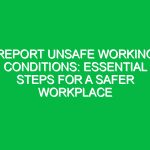Introduction
In the realm of Health, Safety, and Environment (HSE), the concept of “reduced risk” plays a pivotal role in safeguarding individuals, communities, and ecosystems. The reduced risk definition refers to the systematic process of identifying, assessing, and mitigating potential Hazards that may lead to adverse outcomes in various settings, from industrial workplaces to natural environments. Understanding and implementing reduced risk strategies is not merely a regulatory requirement; it is a commitment to ensuring a safer and more sustainable future for all stakeholders involved.
As industries continue to evolve, so do the complexities of the risks they face. From chemical spills to workplace accidents, the stakes can be high. Therefore, grasping the nuances of reduced risk can make a significant difference in operational efficiency and overall Safety. In this article, we will delve into the essential aspects of reduced risk definition in the HSE context, exploring its components, methodologies, and the vital Regulations that govern it.
The Core Components of Reduced Risk Definition
To fully appreciate the reduced risk definition, it is necessary to break it down into its core components. These elements not only inform our understanding of risks but also guide the strategies we employ to mitigate them effectively.
1. Risk Identification
The initial step in the reduced risk process involves identifying potential Hazards. This can include anything from machinery malfunctions to environmental degradation. For instance, in a manufacturing facility, the use of heavy machinery presents various risks, such as operator injury or equipment failure. Conducting thorough risk assessments is crucial in this stage. Techniques such as hazard and operability studies (HAZOP) or fault tree analysis can be instrumental in uncovering hidden risks.
2. Risk Assessment
Once identified, the next step is risk assessment, which involves evaluating the likelihood and potential impact of each hazard. This step is often facilitated through qualitative and quantitative analysis, where the risks are categorized based on their severity and probability of occurrence. For example, a chemical processing plant might assess the risk of a toxic gas leak, determining both the frequency and potential consequences of such an event. The insights gained from this assessment are vital for prioritizing risks and developing appropriate mitigation strategies.
3. Risk Control Measures
Implementing effective risk Control Measures is at the heart of the reduced risk definition. These measures can range from engineering controls, such as installing Safety guards on machinery, to administrative controls like implementing strict safety protocols. Personal protective equipment (PPE) also plays a crucial role in reducing individual exposure to risks. The choice of control measures should be guided by the hierarchy of controls, which emphasizes eliminating hazards first, followed by substitution, engineering controls, administrative actions, and lastly, PPE.
4. Continuous Monitoring and Improvement
Reduced risk is not a one-time effort; it requires ongoing monitoring and improvement. Regular audits and safety assessments should be conducted to ensure that the controls in place remain effective and relevant. This is where the concept of a safety culture becomes essential. In organizations where safety is prioritized, employees are more likely to report hazards and suggest improvements, creating a proactive approach to risk management.
Benefits of Reduced Risk Definition in HSE
Understanding and effectively implementing the reduced risk definition offers several Benefits that extend beyond mere compliance with regulations.
1. Enhanced Safety
The most immediate benefit of reducing risks is enhanced safety for employees and the surrounding community. By proactively identifying and addressing hazards, organizations can significantly decrease the likelihood of accidents and incidents. For example, a construction company that implements strict safety protocols reduces the chances of falls or equipment-related injuries among its workers.
2. Improved Compliance
Regulatory bodies enforce numerous Standards and guidelines to ensure safety in various industries. By adopting reduced risk practices, organizations can not only meet these legal requirements but often exceed them. This proactive approach can lead to fewer fines, legal actions, and reputational damage associated with safety violations.
3. Cost Savings
Investing in reduced risk strategies can lead to substantial cost savings in the long run. Fewer accidents mean lower medical expenses, reduced insurance premiums, and less downtime due to injuries or accidents. For example, a manufacturing facility that invests in safety Training for its employees may see a decrease in workplace accidents, ultimately leading to lower costs associated with worker’s compensation claims.
4. Positive Impact on Environment
In addition to protecting individuals, reduced risk practices also contribute to environmental Sustainability. By identifying and mitigating risks associated with environmental hazards, organizations can minimize their ecological footprint. For instance, an oil refinery that implements spill Prevention measures can significantly reduce the risk of environmental contamination, protecting local ecosystems.
Best Practices for Implementing Reduced Risk Definition
To effectively implement the reduced risk definition within an HSE framework, organizations should consider several Best Practices.
1. Leadership Commitment
Leadership commitment is crucial in fostering a safety culture. When leaders prioritize safety and demonstrate a genuine investment in risk management, it sets the tone for the entire organization. Employees are more likely to engage in safety initiatives when they see their leaders taking risks seriously.
2. Training and Education
Regular training and education are essential for equipping employees with the necessary skills to identify and mitigate risks. Training should not be a one-time event but an ongoing process that adapts to changing conditions and emerging risks. For example, a chemical plant might implement annual refresher courses on handling hazardous materials to ensure that all employees remain aware of Safe Practices.
3. Employee Involvement
Encouraging employee involvement in safety initiatives can lead to valuable insights and improvements. Employees on the front lines often have a unique perspective on potential hazards and can contribute to effective risk management. Implementing suggestion programs or safety committees can facilitate this involvement.
4. Incident Reporting and Analysis
Establishing a robust system for incident reporting and analysis is essential for continuous improvement. When incidents occur, organizations should conduct thorough investigations to understand the root causes and implement corrective actions. This not only helps prevent similar incidents in the future but also reinforces a culture of transparency and accountability.
Regulations and Standards Governing Reduced Risk Definition
Several regulations and standards govern the implementation of reduced risk definitions in various industries. Understanding these regulations is key to compliance and effective risk management.
1. Occupational Safety and Health Administration (OSHA)
In the United States, osha sets forth regulations that require employers to provide a safe working environment. This includes the identification and mitigation of risks associated with workplace hazards. Compliance with OSHA regulations is not optional; it is a legal requirement that can have significant implications for organizations.
2. Environmental Protection Agency (EPA)
The EPA enforces regulations aimed at protecting the environment and public health. Organizations must adhere to guidelines concerning hazardous waste management, emissions control, and spill prevention. Understanding these regulations ensures that companies not only reduce risks internally but also contribute to broader environmental sustainability.
3. International Organization for Standardization (ISO)
ISO standards, particularly ISO 45001, provide a framework for managing Occupational Health and safety risks. Organizations that comply with these standards demonstrate a commitment to effective risk management and continuous improvement. Certification to ISO standards can also enhance an organization’s reputation and credibility in the marketplace.
Conclusion
The reduced risk definition within the HSE context is a vital aspect of modern operational practices. By understanding its core components—risk identification, assessment, control measures, and continuous improvement—organizations can create safer environments for their employees and communities. The benefits of implementing reduced risk strategies are manifold, encompassing enhanced safety, improved compliance, cost savings, and positive environmental impacts.
In a world where risks are constantly evolving, organizations must remain vigilant and proactive in their approach to risk management. By prioritizing leadership commitment, employee involvement, and continuous training, they can foster a culture of safety that not only meets regulatory requirements but also champions health, safety, and environmental sustainability. It is imperative for organizations to reflect on their practices and take action toward integrating reduced risk strategies into their operations, ensuring a safer future for all.


